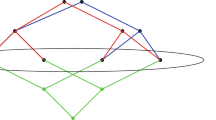Abstract
A homomorphism from a graph G to a graph H (in this paper, both simple, undirected graphs) is a mapping f:V(G)→V(H) such that if uv∈E(G) then f(u)f(v)∈E(H). The problem Hom (G,H) of deciding whether there is a homomorphism is NP-complete, and in fact the fastest known algorithm for the general case has a running time of O *(n(H)cn(G)) (the notation O *(⋅) signifies that polynomial factors have been ignored) for a constant 0<c<1. In this paper, we consider restrictions on the graphs G and H such that the problem can be solved in plain-exponential time, i.e. in time O *(c n(G)+n(H)) for some constant c.
Previous research has identified two such restrictions. If H=K k or contains K k as a core (i.e. a homomorphically equivalent subgraph), then Hom (G,H) is the k-coloring problem, which can be solved in time O *(2n(G)) (Björklund, Husfeldt, Koivisto); and if H has treewidth at most k, then Hom (G,H) can be solved in time O *((k+3)n(G)) (Fomin, Heggernes, Kratsch). We extend these results to cases of bounded cliquewidth: if H has cliquewidth at most k, then we can count the number of homomorphisms from G to H in time O *((2k+1)max (n(G),n(H))), including the time for finding a k-expression for H. The result extends to deciding Hom (G,H) when H has a core with a k-expression, in this case with a somewhat worse running time.
If G has cliquewidth at most k, then a similar result holds, with a worse dependency on k: We are able to count Hom (G,H) in time O *((2k+1)n(G)+22kn(H)), and this also extends to when G has a core of cliquewidth at most k with a similar running time.
Similar content being viewed by others
References
Amini, O., Fomin, F.V., Saurabh, S.: Counting subgraphs via homomorphisms. In: ICALP, vol. 1, pp. 71–82 (2009)
Björklund, A., Husfeldt, T., Koivisto, M.: Set partitioning via inclusion-exclusion. SIAM J. Comput. 39(2), 546–563 (2009)
Byskov, J.M.: Exact algorithms for graph colouring and exact satisfiability. PhD thesis, University of Aarhus (2005)
Corneil, D.G., Habib, M., Lanlignel, J.-M., Reed, B.A., Rotics, U.: Polynomial time recognition of clique-width ≤ 3 graphs (extended abstract). In: LATIN, pp. 126–134 (2000)
Courcelle, B., Engelfriet, J., Rozenberg, G.: Handle-rewriting hypergraph grammars. J. Comput. Syst. Sci. 46, 218–270 (1993)
Courcelle, B., Olariu, S.: Upper bounds to the clique width of graphs. Discrete Appl. Math. 101(1–3), 77–114 (2000)
Downey, R.G., Fellows, M.: Parameterized Complexity. Monographs in Computer Science. Springer, Berlin (1999)
Eppstein, D.: Small maximal independent sets and faster exact graph coloring. J. Graph Algorithms Appl. 7(2), 131–140 (2003)
Fellows, M.R., Rosamond, F.A., Rotics, U., Szeider, S.: Clique-width minimization is NP-hard. In: STOC, pp. 354–362 (2006)
Flum, J., Grohe, M.: Parameterized Complexity Theory. Springer, Berlin (2006)
Fomin, F.V., Heggernes, P., Kratsch, D.: Exact algorithms for graph homomorphisms. Theory Comput. Syst. 41(2), 381–393 (2007)
Golumbic, M.C., Rotics, U.: On the clique-width of perfect graph classes. In: WG, pp. 135–147 (1999)
Grohe, M.: The complexity of homomorphism and constraint satisfaction problems seen from the other side. J. ACM 54(1) (2007)
Gutin, G., Hell, P., Rafiey, A., Yeo, A.: A dichotomy for minimum cost graph homomorphisms. Eur. J. Comb. 29, 900–911 (2008)
Gutin, G., Rafiey, A., Yeo, A.: Minimum cost and list homomorphisms to semicomplete digraphs. Discrete Appl. Math. 154(6), 890–897 (2006)
Gutin, G., Rafiey, A., Yeo, A., Tso, M.: Level of repair analysis and minimum cost homomorphisms of graphs. Discrete Appl. Math. 154(6), 881–889 (2006)
Hell, P., Nešetřil, J.: On the complexity of H-coloring. J. Comb. Theory, Ser. B 48(1), 92–110 (1990)
Hell, P., Nešetřil, J.: Graphs and Homomorphisms. Oxford University Press, Oxford (2004)
Impagliazzo, R., Paturi, R., Zane, F.: Which problems have strongly exponential complexity? J. Comput. Syst. Sci. 63(4), 512–530 (2001)
Jonsson, P., Nordh, G., Thapper, J.: The maximum solution problem on graphs. In: MFCS, pp. 228–239 (2007)
Lawler, E.: A note on the complexity of the chromatic number problem. Inf. Process. Lett. 5, 66–67 (1976)
Oum, S.-I.: Approximating rank-width and clique-width quickly. ACM Trans. Algorithms 5(1), 1–20 (2008)
Traxler, P.: The time complexity of constraint satisfaction. In: IWPEC, pp. 190–201 (2008)
Williams, R.: A new algorithm for optimal 2-constraint satisfaction and its implications. Theor. Comput. Sci. 348(2–3), 357–365 (2005)
Author information
Authors and Affiliations
Corresponding author
Rights and permissions
About this article
Cite this article
Wahlström, M. New Plain-Exponential Time Classes for Graph Homomorphism. Theory Comput Syst 49, 273–282 (2011). https://doi.org/10.1007/s00224-010-9261-z
Published:
Issue Date:
DOI: https://doi.org/10.1007/s00224-010-9261-z




